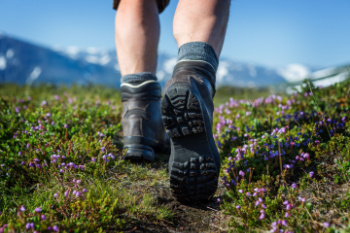 Foot care is essential for hikers to prevent common issues like blisters, overuse injuries, and fungal infections. Start by choosing well-fitted, supportive hiking boots and moisture-wicking socks to reduce friction and keep your feet dry. It is helpful to break in new boots before long hikes to avoid blisters. If blisters occur, clean them with an antiseptic and cover them with a blister pad to prevent further irritation. To guard against overuse injuries, gradually increase hiking distances and ensure proper conditioning and stretching. Pay attention to any signs of pain or discomfort and rest as needed to avoid making injuries worse. Fungal infections thrive in warm, moist environments, so keep your feet clean and dry. Change socks frequently and use antifungal powder if necessary. Let boots dry thoroughly between hikes. Regularly inspect feet for cuts, sores, or signs of infection. If you experience persistent pain, swelling, or other issues from hiking, it is suggested that you consult a podiatrist for professional advice and treatment.
Foot care is essential for hikers to prevent common issues like blisters, overuse injuries, and fungal infections. Start by choosing well-fitted, supportive hiking boots and moisture-wicking socks to reduce friction and keep your feet dry. It is helpful to break in new boots before long hikes to avoid blisters. If blisters occur, clean them with an antiseptic and cover them with a blister pad to prevent further irritation. To guard against overuse injuries, gradually increase hiking distances and ensure proper conditioning and stretching. Pay attention to any signs of pain or discomfort and rest as needed to avoid making injuries worse. Fungal infections thrive in warm, moist environments, so keep your feet clean and dry. Change socks frequently and use antifungal powder if necessary. Let boots dry thoroughly between hikes. Regularly inspect feet for cuts, sores, or signs of infection. If you experience persistent pain, swelling, or other issues from hiking, it is suggested that you consult a podiatrist for professional advice and treatment.
Sports related foot and ankle injuries require proper treatment before players can go back to their regular routines. For more information, contact Michael Bess, DPM of Florida. Our podiatrist can provide the care you need to keep you pain-free and on your feet.
Sports Related Foot and Ankle Injuries
Foot and ankle injuries are a common occurrence when it comes to athletes of any sport. While many athletes dismiss the initial aches and pains, the truth is that ignoring potential foot and ankle injuries can lead to serious problems. As athletes continue to place pressure and strain the area further, a mild injury can turn into something as serious as a rupture and may lead to a permanent disability. There are many factors that contribute to sports related foot and ankle injuries, which include failure to warm up properly, not providing support or wearing bad footwear. Common injuries and conditions athletes face, including:
- Plantar Fasciitis
- Plantar Fasciosis
- Achilles Tendinitis
- Achilles Tendon Rupture
- Ankle Sprains
Sports related injuries are commonly treated using the RICE method. This includes rest, applying ice to the injured area, compression and elevating the ankle. More serious sprains and injuries may require surgery, which could include arthroscopic and reconstructive surgery. Rehabilitation and therapy may also be required in order to get any recovering athlete to become fully functional again. Any unusual aches and pains an athlete sustains must be evaluated by a licensed, reputable medical professional.
If you have any questions please feel free to contact our office located in West Palm Beach, FL . We offer the newest diagnostic and treatment technologies for all your foot and ankle needs.
